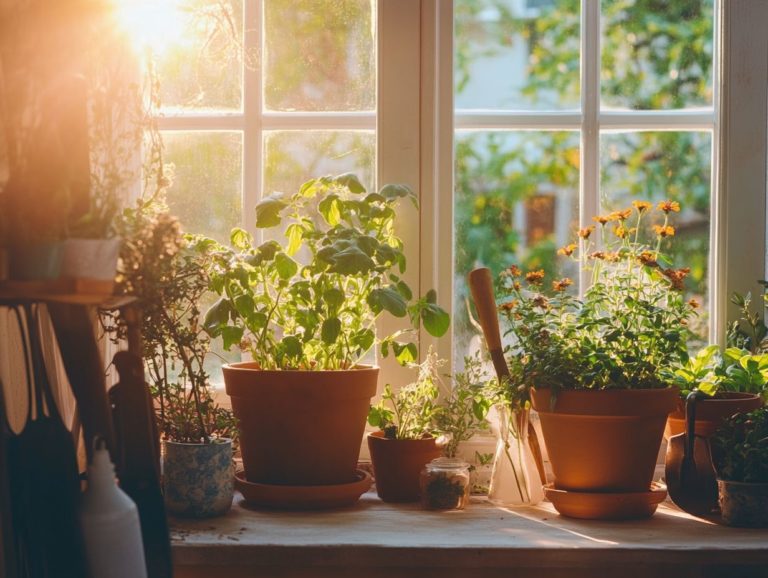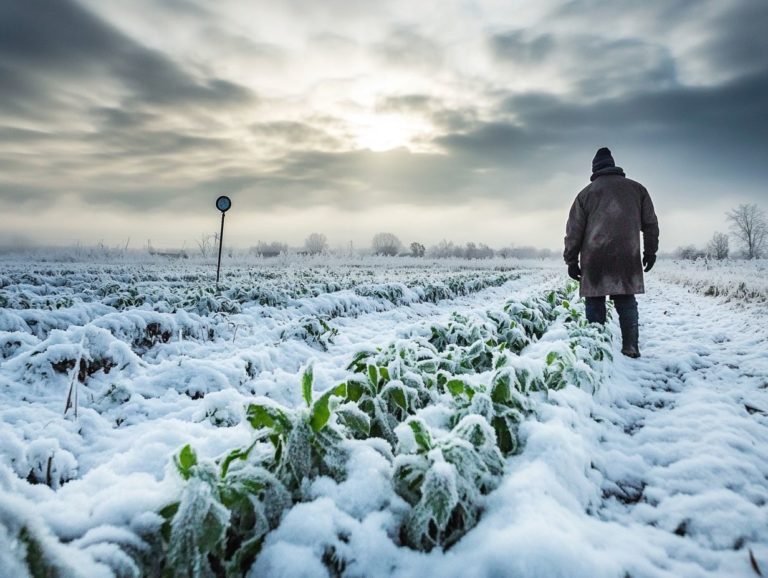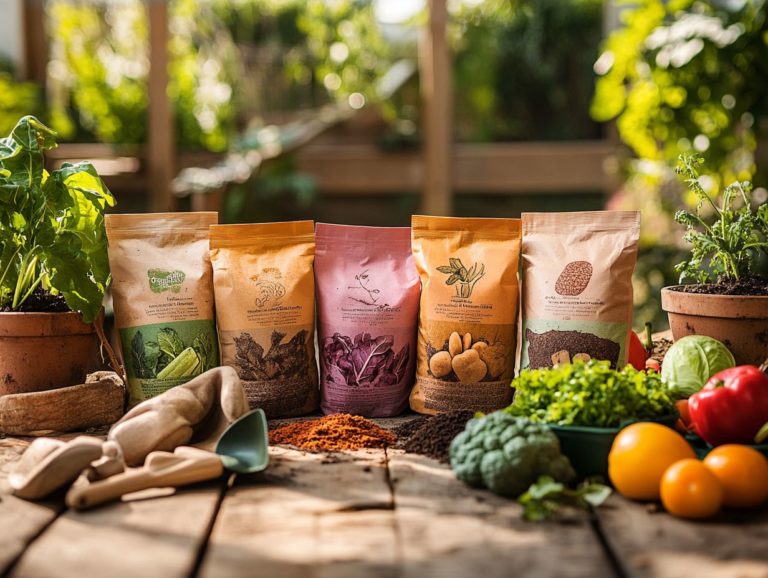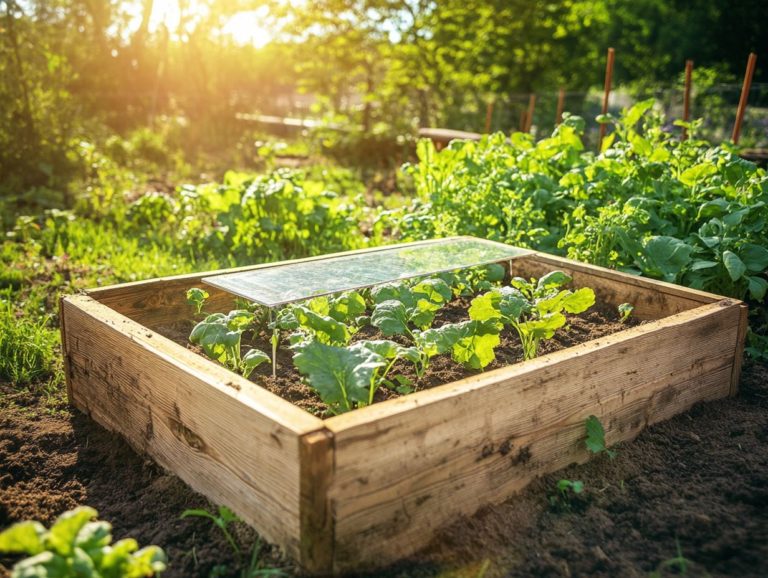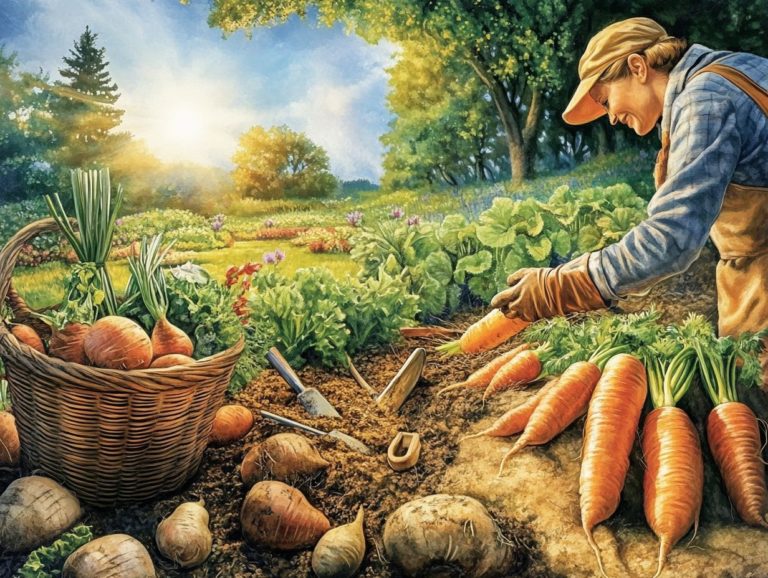Best Cold-Hardy Vegetables for Winter Gardens
As winter descends and the air turns crisp, you might think that gardening has come to a standstill. Not so fast! Vegetables that grow well in cold weather flourish even in these frigid temperatures, providing a wealth of flavors and nutrients during the coldest months.
This guide will introduce you to the finest vegetables to cultivate in winter, highlighting their remarkable benefits and inspiring ways to incorporate them into your seasonal meals. You’ll also discover essential tips for successful gardening, ensuring that your winter harvest is as vibrant and rewarding as it can be.
Contents
- Key Takeaways:
- 1. Kale
- 2. Spinach
- 3. Brussels Sprouts
- 4. Carrots
- 5. Beets
- 6. Swiss Chard
- 7. Cabbage
- 8. Broccoli
- 9. Cauliflower
- 10. Parsnips
- 11. Turnips
- 12. Radishes
- 13. Collard Greens
- 14. Mustard Greens
- 15. Lettuce
- What Makes These Vegetables Cold-Hardy?
- Frequently Asked Questions
- What are the best cold-hardy vegetables for winter gardens?
- Can I grow these vegetables in all regions?
- Do I need to start these vegetables indoors before planting in my winter garden?
- How often should I water these vegetables during the winter?
- Can I use a cold frame or greenhouse to extend the growing season for these vegetables?
- When is the best time to harvest cold-hardy vegetables?
Key Takeaways:
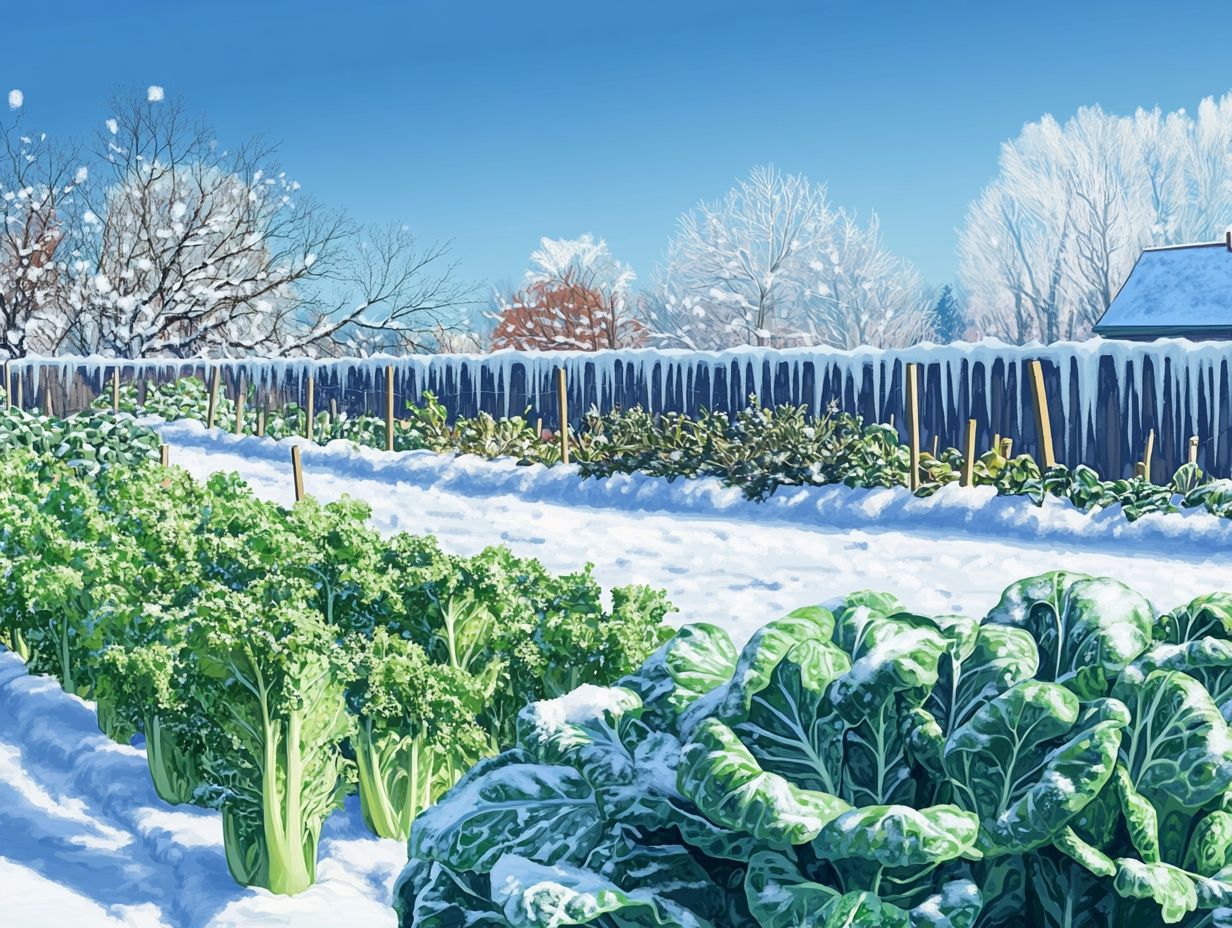
- Kale, spinach, and Brussels sprouts are some of the best vegetables that grow well in cold weather, providing a nutrient-rich and resilient addition to any garden.
- These vegetables can withstand cold temperatures and even improve in flavor after being exposed to frost, making them ideal for winter gardening.
- There are many different varieties of these cold-weather vegetables, offering a range of colors, flavors, and textures to incorporate into dishes and salads during the winter months.
1. Kale
Kale stands out as a versatile and nutritious leafy green that thrives in winter gardening. It’s an excellent choice for anyone in colder climates eager to savor homegrown vegetables year-round.
This resilient plant not only withstands frost but actually enhances its flavor after exposure to colder temperatures. The result is a sweeter taste during the winter harvest. Packed with vitamins A, C, and K, kale brings a plethora of health benefits to your table, making it a fantastic addition to any diet.
In terms of winter gardening, specific varieties like Winterbor and Lacinato are renowned for their exceptional cold tolerance. For more insights, consider choosing the right vegetables for winter. Proper soil preparation is key; ensuring your soil is well-drained and rich in organic matter will promote vigorous growth.
By following a strategic planting schedule in late summer or early fall, you’ll give your kale ample time to establish itself before the heavy frost arrives. If space is tight, consider container gardening as an effective alternative. Just remember to water regularly and position your plants in sunlight to maximize yield.
2. Spinach
Spinach stands out as a powerhouse among leafy greens, offering a wealth of health benefits while thriving as a cold-tolerant crop for winter gardening. Imagine enjoying fresh produce even during the chillier months.
To cultivate this versatile vegetable effectively, focus on well-drained, fertile soil enriched with organic matter, essential for optimal growth and yield. Opt for slow-bolting seed varieties to guarantee a longer harvest, and practice planting new seeds every few weeks to ensure a continuous harvest.
As temperatures dip, consider using row covers to shield your crops from frost. This can extend their longevity and make winter harvesting a viable option. When you find yourself with an excess yield, blanching and freezing your spinach is a smart way to preserve those nutrients, allowing you to enjoy them long after the last harvest.
This approach not only reduces waste but also embraces sustainable gardening practices.
3. Brussels Sprouts
Brussels sprouts are a remarkable cruciferous vegetable that flourishes in winter gardening, offering you a generous harvest when planted and managed with care throughout the colder months.
To achieve optimal growth, these vegetables thrive in well-drained, nutrient-rich soil with a pH between 6.0 and 7.0. Preparing your soil means thorough tilling and adding organic compost, which boosts fertility and helps retain moisture.
Light conditions are vital; ensure they receive full sun exposure for at least six hours each day. Manage your crops by regularly checking for pests like aphids and caterpillars and employing natural pest control methods to keep them at bay.
As harvest time draws near, knowing when to pick those little green gems typically after the first frost will significantly enhance their flavor and guarantee a successful, bountiful yield for you.
Get ready to enjoy delicious homegrown vegetables even in winter! Start your winter garden today!
4. Carrots
Carrots are a quintessential root vegetable that you can grow effectively during the winter months. They are an essential component of your winter gardening strategy, focusing on fresh produce and nutrient retention.
There are several varieties, like ‘Napoli’, ‘Danvers’, and ‘Kuroda’, that thrive in cooler temperatures. This allows you to choose the best types for your specific climate.
Prepare the soil by enriching it with organic matter. Ensure proper drainage, which helps those roots develop optimally.
Aim to plant in late summer to early fall. This gives the carrots ample time to establish themselves before frost arrives. During the frost season, regular monitoring and care are vital. Keeping the soil adequately moist while mulching will protect the roots from freezing, guaranteeing a tender and flavorful crop come spring.
5. Beets
Beets are an exceptional root vegetable that fits seamlessly into winter gardening. With thoughtful planning and care, you can relish homegrown produce throughout the colder months.
By choosing the right varieties, such as Detroit Dark Red or Golden Beet, you can ensure vigorous growth even when temperatures dip. Preparing the soil is essential; well-draining, nutrient-rich soil promotes strong root development.
As winter looms, consider your harvest timing and methods. These factors are critical for managing a successful yield.
Explore fun preservation techniques now, like canning or storing them in a cool, dark place, to enjoy your beets all winter long. Imagine incorporating them into comforting winter recipes that nourish the body and warm the soul.
6. Swiss Chard
Swiss chard is a nutrient-rich leafy green that flourishes in winter gardening. It s an ideal choice if you want to maximize your garden space while enjoying fresh produce during the colder months.
This hardy vegetable isn t just frost-resistant; it actually thrives in it. The cold temperatures enhance its natural sweetness. For successful growth, you ll want well-draining soil with a pH between 6.0 and 7.0 adding organic matter can significantly improve soil quality.
For optimal crop management, regular watering and mulching will help maintain moisture levels and keep pesky weeds at bay. Growing Swiss chard is a breeze, making it perfect for winter gardens. In the kitchen, it elevates winter recipes, adding a unique flavor to simple dishes like soups and stews, contributing to a nutritious diet even in the chillier months.
7. Cabbage

Cabbage is a resilient cruciferous vegetable that truly thrives in winter gardening. For more insights, consider selecting plants for a winter garden to ensure a dependable source of fresh produce and a myriad of culinary possibilities during the colder months.
With a range of types, including Savoy, Napa, and winter white cabbages, each variety brings its own unique textures and flavors to your table. To get the most out of your cabbage, sow seeds indoors about six to eight weeks before the last frost or transplant seedlings outdoors between mid to late summer.
Proper soil preparation is essential for successful winter cabbage cultivation. Ensure your soil is well-drained and nutrient-rich, with a pH ranging from 6.0 to 6.8. To fend off pests like aphids and cabbage worms, use strategies such as row covers, companion planting, and regular monitoring for signs of infestation.
By maximizing these techniques, you are setting yourself up for a bountiful harvest, no matter the winter challenges that arise. Start planting these vegetables today and enjoy fresh, homegrown produce all winter!
8. Broccoli
Broccoli is a nutrient-dense cruciferous vegetable that you can successfully cultivate in your winter garden. To enhance your cold-season repertoire, learn how to choose the right winter vegetables for a thriving garden.
Select the right seeds and ensure the best growing conditions for a bountiful harvest. Choose varieties specifically bred for cooler climates; they thrive even in low temperatures.
Proper soil preparation is key. Enrich the soil with organic matter, and make sure it drains well, as ample sunlight and moisture are crucial for healthy growth. Regular garden care like monitoring soil pH (the level of acidity in the soil) and fertilization will enhance the quality of your crop.
Implement pest management strategies, such as companion planting and introducing natural predators, to keep your garden vibrant. Mastering the techniques for harvesting broccoli ensures that its flavor and nutrients are preserved, elevating your winter meals.
9. Cauliflower
Cauliflower is a remarkably versatile cruciferous vegetable that thrives in winter gardening. It rewards you with delightful, homegrown produce even in the coldest months.
This hardy plant flourishes in cooler temperatures, making it an excellent choice for extending your growing season in your garden space.
For winter planting, consider varieties like frost-tolerant vegetables:
- ‘Snowball’
- ‘Winter White’
- ‘Graffiti’
Each of these varieties adds unique flavors and colors that can elevate any dish from your seasonal gardening.
To grow healthy cauliflower, prepare the soil well. Add organic matter and ensure it drains properly, as this is critical for growing vegetables.
Cauliflower thrives in full to partial sunlight, so choose a location that receives adequate light. Use techniques such as changing where you plant and careful watering to enhance your yield of winter vegetables. Timely harvesting will guarantee peak flavor and texture.
10. Parsnips
Parsnips are a heart root vegetable that actually sweetens after a touch of frost, making them an excellent choice for cold season gardening.
To ensure a thriving harvest, pay close attention to your planting schedules, seed starting practices, and soil conditions. Aim for temperatures between 50 F and 70 F, and use well-drained, fertile soil. This is essential for promoting vigorous growth and nutrient retention.
Regular crop management practices like mulching and proper watering can greatly boost your yield of fresh produce.
Don t wait too long to harvest! Use a fork to gently lift the roots; this minimizes damage and keeps your parsnips in top shape for vegetable preservation.
To preserve your parsnips through the chillier months, store them in a cool, dark place or freeze them. This will maintain their flavor and texture, ensuring they remain a staple ingredient in your kitchen long into winter.
11. Turnips
Turnips are not just any root vegetable; they re a powerhouse of nutrition that thrives in winter gardening. They effortlessly elevate your seasonal recipes while providing essential nutrients during the colder months.
These hardy plants thrive in frosty conditions, making them a prime choice for winter harvests. Among the many varieties available, consider Purple Top White Globe and Hakurei both known for their outstanding resilience and delightful flavor.
Prepare your soil with organic matter and ensure it drains well, as this is essential for growing conditions.
When planting, space turnips about 4 to 6 inches apart to allow for robust development. Regular watering and diligent pest monitoring can significantly improve your crop management.
For the best yield, time your harvest when the roots reach about 2 to 3 inches in diameter. Store them in a cool, dark place to maintain their freshness for as long as possible and enhance your vegetable gardening skills.
12. Radishes
Radishes are an excellent pick for your winter garden! They grow quickly and adapt well, giving you fresh, crunchy veggies even in the cold.
Consider several varieties that thrive in winter cultivation, like ‘Daikon’, known for its mild flavor, or the robust ‘Winter Radish’, praised for its frost resistance.
When planning your planting schedule, aim to sow these seeds from late summer to early fall, aligning with your garden planning. This timing helps radishes grow before the chill sets in, maximizing your seasonal produce.
Radishes thrive in well-drained, loose soil enriched with organic matter. This creates the perfect environment for their development as part of your soil preparation.
Throughout their growth, keep an eye on moisture levels and provide necessary care, including mulching for insulation as part of effective garden care.
When harvest time arrives, these root vegetables can elevate your winter recipes. They add a delightful spicy kick to hearty soups and vibrant salads, enhancing your seasonal gardening efforts.
13. Collard Greens
Collard greens are a superfood for your winter garden! They re nutrient-dense and will elevate your intake of homegrown vegetables during the colder months while boosting your emotional well-being.
For optimal growth, this robust green prefers well-draining, fertile soil teeming with organic matter, which improves soil health. Aim for a pH level around 6.0 to 6.8; enhancing your soil with compost or aged manure can significantly boost nutrient availability.
In terms of light conditions, collard greens flourish best in full sun, though they ll tolerate some partial shade as long as they receive adequate care.
Regular crop management such as consistent watering and mulching helps maintain moisture levels and suppress those pesky weeds, contributing to successful maintaining crops.
Keeping an eye out for pests like aphids or cabbage worms is crucial for ensuring a healthy yield of your leafy greens. As winter progresses, you ll find these greens effortlessly fitting into comforting soups and stews, enriching your seasonal recipes with both flavor and nutrition while utilizing your culinary skills.
14. Mustard Greens
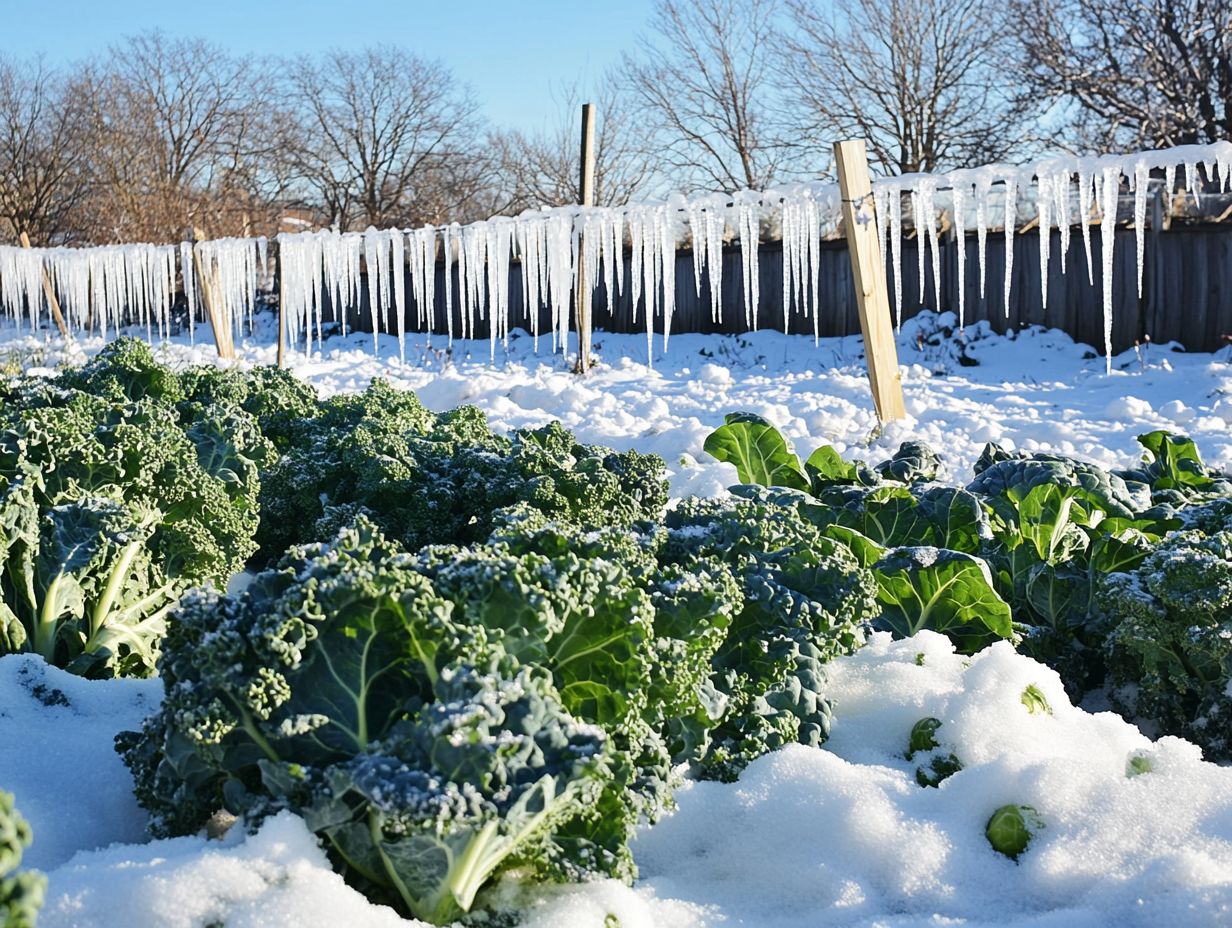
Mustard greens are a delightful addition to your winter garden, offering a zesty kick to salads and various dishes while guaranteeing a steady supply of fresh produce throughout the season.
These vibrant greens come in many varieties, such as Tendergreen, celebrated for its mild flavor, and Southern Giant Curled, which features a robust texture that s ideal for cooking.
To achieve optimal growth, it’s essential to prepare your soil by enriching it with compost and ensuring proper drainage. Mustard greens thrive best in loamy, nutrient-rich environments.
When planting, be sure to space each seedling adequately to promote healthy air circulation. This is crucial for preventing disease and contributes to effective garden care.
Engaging in succession planting will allow you to enjoy a staggered harvest, providing you with fresh greens for an extended period and enhancing your vegetable gardening experience.
Regular watering and vigilant pest monitoring will help keep your crop healthy, resulting in a thriving winter garden and a rewarding gardening experience.
15. Lettuce
Lettuce is a crisp and refreshing leafy green. It thrives in winter gardening and brings essential nutrients to your meals. Plus, growing vegetables can boost your emotional well-being!
If you’re up for the challenge of growing this vibrant vegetable in colder months, you ll find several lettuce varieties that shine, such as butterhead, romaine, and loose-leaf types.
Preparing your soil is key; it should be well-drained and rich in organic matter to ensure optimal growth and maintain soil conditions. Careful planning of your planting schedule, aligned with frosty conditions, can help maximize your yield of leafy greens.
Regular garden maintenance like consistent watering and pest management will further enhance your lettuce s growth and ensure a robust harvest. Beyond the practicalities, immersing yourself in winter gardening can lift your spirits. It provides a therapeutic escape as you connect with nature and enjoy the delightful rewards of freshly harvested produce during the chilly season while managing your gardening techniques.
What Makes These Vegetables Cold-Hardy?
Cold-hardy vegetables are your best allies when braving low temperatures and frost. They make perfect companions for winter gardening, especially in Northern growers regions. For the best options, check out the top 10 winter vegetables for cold climates. Not only do they ensure a steady supply of fresh produce, but they help elevate your emotional well-being during the colder months, combating Seasonal Affective Disorder.
These tough plants have adapted in amazing ways. They increase the levels of certain substances in their cells, which helps to lower the freezing point of their fluids. This clever adaptation allows them to thrive even in harsh winter environments, ensuring a successful winter gardening guide.
Their ability to photosynthesize under lower light conditions means you can enjoy vibrant greens even during the gloomiest months vital for your winter gardening. Engaging with these robust crops in community gardening projects cultivates not only plants but also a sense of connection and accomplishment that greatly enhances your mental health.
Nurturing these vegetables together acts as a powerful remedy for the winter blues, fostering bonds among participants while encouraging a shared appreciation for sustainable living and the benefits of vegetable gardening.
What Are the Benefits of Growing Cold-Hardy Vegetables?
Growing cold-hardy vegetables in your winter garden offers a wealth of benefits. You get to enjoy fresh produce during the chill of winter while boosting your emotional well-being through the simple act of gardening. For those curious about what to plant, check out what vegetables grow best in cold climates.
These resilient plants, like kale, spinach, and various root vegetables, not only enhance your diet with essential nutrients but also contribute to a more sustainable lifestyle. They reduce your reliance on store-bought produce and lower your carbon footprint through garden planning.
Engaging in winter gardening connects you with nature, providing a delightful antidote to stress and anxiety. It enhances your overall gardening experience. Nurturing your crops offers a satisfying sense of accomplishment. This contributes positively to your emotional well-being.
The rhythmic rituals of planting, tending, and harvesting promote physical activity and create moments of mindfulness. This leads you to a more balanced state of mind throughout the winter months, which is essential for your gardening techniques.
What Are the Different Varieties of These Vegetables?
You have many vegetable options that can survive cold weather for winter gardening. Consider exploring the top 10 winter vegetables for your garden to choose selections that suit your growing conditions and personal preferences.
Among these, kale varieties like ‘Winterbor’ and ‘Dwarf Blue Curled’ excel in cooler temperatures. They offer you an abundance of rich, nutrient-dense leaves to enjoy.
Similarly, certain carrot types, such as ‘Danvers 126’ and ‘Nantes’, can withstand frosty nights. They actually become sweeter as the temperature drops.
You should also consider spinach, particularly ‘Winter Bloomsdale’ and ‘Tuffy’, which thrive in cooler climates. They are perfect for late-season planting.
Good drainage is crucial for the success of these vegetables. Understanding local climate variations helps you select the best strains for optimal growth.
How Can These Vegetables Be Used in Winter Recipes?
Vegetables that can survive cold weather open the door to a variety of delectable winter recipes. By choosing a variety of cold-climate vegetables, you can relish fresh produce while effectively preserving your harvest for future enjoyment.
By incorporating these resilient ingredients like kale, Brussels sprouts, and root vegetables, you can elevate your winter meals. Creative cooking methods such as roasting, saut ing, and even slow-cooking enhance their natural flavors.
Utilizing preservation techniques like canning or freezing ensures that these seasonal treasures can be enjoyed long after the last frost has passed. You’ll love crafting vibrant soups, hearty casseroles, and colorful stir-fries that warm you up on chilly winter nights.
What Are Some Tips for Growing These Vegetables Successfully?
Successful growth of cold-hardy vegetables in winter gardening hinges on your understanding of specific growing conditions. For those just starting out, exploring the top 5 cold-weather vegetables for beginners can help you implement effective techniques to cultivate healthy, productive plants.
Start by properly preparing the soil, incorporating organic matter to enhance both nutrients and drainage. Planning a planting schedule is essential; choosing the right varieties that flourish in lower temperatures can lead to bountiful harvests.
As seedlings begin to emerge, take the time to gradually expose them to outdoor conditions. This process boosts their resilience.
Continuous care is crucial; regular watering and mulching to maintain soil temperature are vital for sustaining plant health.
Tackling common winter challenges, such as frost damage and insufficient sunlight, can be effectively managed with row covers or cold frames. This ensures your garden thrives even in the coldest months.
Frequently Asked Questions
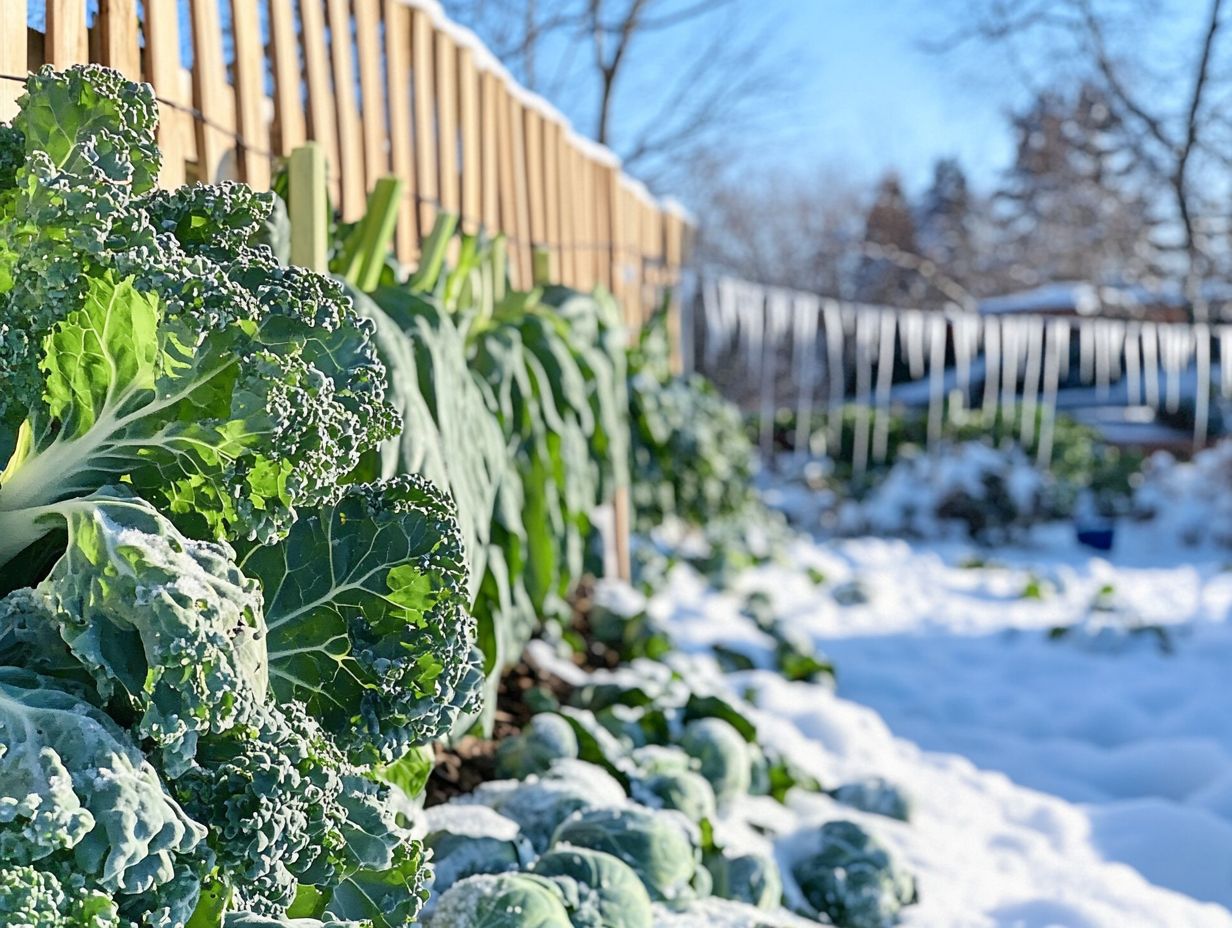
What are the best cold-hardy vegetables for winter gardens?
The best cold-hardy vegetables for winter gardens include kale, spinach, Brussels sprouts, carrots, beets, and vegetables that thrive in cold weather like collard greens.
Can I grow these vegetables in all regions?
Yes, you can grow these vegetables in all regions where winter temperatures don t consistently drop below freezing.
Do I need to start these vegetables indoors before planting in my winter garden?
It is recommended to start these vegetables indoors before planting in your winter garden. They will have a head start and be more established before colder temperatures arrive.
How often should I water these vegetables during the winter?
Watering frequency depends on the amount of rainfall and climate in your region. Check the soil moisture regularly and water when the top inch of soil is dry.
Can I use a cold frame or greenhouse to extend the growing season for these vegetables?
Yes, using a cold frame or greenhouse can help extend the growing season for these vegetables. They provide protection from harsh winter conditions, but be sure to monitor the temperature and ventilation to prevent overheating.
When is the best time to harvest cold-hardy vegetables?
The best time to harvest depends on the type of vegetable. Check the harvest time for each one to enjoy your garden’s bounty!
Don’t wait too long! Harvest them before the ground freezes for the best flavor.

